Forklift Tires & Wheels – What You Need To Know To Keep Rolling
- share
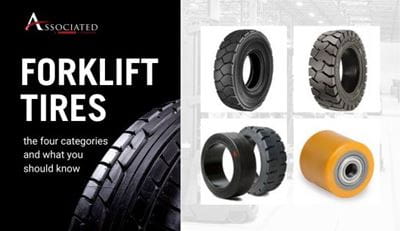
Forklift tires are one of those things that few people pay any attention to until they fail.
Most people don’t realize that the tire type and condition can really affect the performance of lift trucks. Worn tires can lead to excessive fuel consumption/battery discharge, overheating, and even physical damage to components. Let’s take a look at types of tires, tread and composite differences, as well as special considerations.
Forklift tires are one of those things that few people pay any attention to until they fail. Most people don’t realize that the tire type and condition can really affect the performance of lift trucks. Worn tires can lead to excessive fuel consumption/battery discharge, overheating, and even physical damage to components. Let’s take a look at types of tires, tread and composite differences, as well as special considerations.
Forklift tires have three main categories:
- Air Pneumatic
- Solid Pneumatic
- Cushion/Press-on
Load wheels are a separate ballgame and come in a variety of solid compounds.
Air Pneumatic Tires
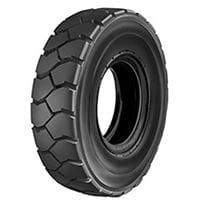
Air-filled pneumatic tires are the classic tire style for conventional sit-down forklifts. They are similar in concept to automotive tires in that they're filled with air, but are designed to handle the extreme loads that forklifts carry. They are also designed to operate at much higher air pressures, usually 100-120 PSI. Because of these pressures and loads it is especially critical that they are maintained properly, as any failure can be extremely dangerous. Low tires can cause a rollover with raised loads, and a blowout at 100+ PSI can be fatal to a near bystander.
Solid Pneumatic Tires
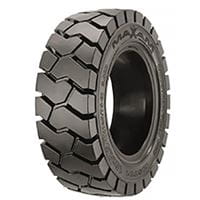
Solid pneumatic tires are solid rubber or composite tires that are designed for trucks normally outfitted with pneumatic tires. They fit the same wheels as their comparable pneumatic tires (bolt-together or split ring rims). The primary reason to use these tires is their increased durability in harsh environments such as recycling plants and other sites with sharp debris.
They are ideal for applications where frequent flat tires are a concern. While they are more expensive to purchase than pneumatic tires, they are economical when long-term usage is considered. A major downside to consider is that they are NOT usually field serviceable, and require a specialized press to install onto the wheels. These tires can be molded in normal tread patterns, but are available in smooth tread for warehouse applications, and also in non-marking compounds (recognizable by their light grey or white color). Non-marking tires do not allow the truck to dissipate static electricity very readily as they are less conductive, so a static strap must be used.
Cushion Tires
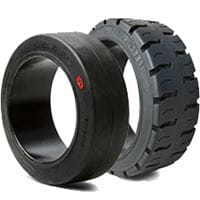
Cushion tires, also known as press-on tires, are solid rubber as well, but are designed to fit special rims. They are molded around a steel ring, which is pressed onto the rim with a high-powered hydraulic press. These types of tires come in a variety of compounds and treads. Most applications are smooth tread for maximum tire life and smoothness of operation. A common alternative is a finely sipped tread, which is remarkably effective for wet surfaces like dock plates.
Similar to pneumatic profile solids, they also are available in non-marking compounds. Again, these require the use of static straps to dissipate static so that on-board electronics are not interfered with or damaged. Lack of a static strap can also equal an unwelcome surprise to the unsuspecting operator when they exit the lift truck!
With solid tires, the biggest factor in performance is the molded compound. Some compounds offer enhanced traction for specific environments, while other may be optimized for durability, smooth ride, or cold storage usage. Usually a tire is given a durometer rating, which denotes its hardness, but is only a part of the picture. A higher durometer rating is harder than a low one. For example, a load wheel with a durometer designation of 80 would be softer than an 85. Be sure to discuss the proper tire for your application when you talk with your parts or service representative. The lowest price may not be the best match, nor is the priciest necessarily the best fit for your application.
Load Wheels
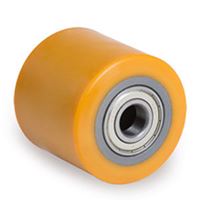
Load-bearing wheels are probably the most overlooked of all these. Some of the things to watch for are debris stuck in the wheel, uneven wear, chunking from the wheel surface, and seized bearings. One of the most common issues is uneven wear. This will lead to accelerated mechanical wear and decreased wheel life. Carrying off-center loads can often result in “coning”, a condition where the load wheels wear more on one side. Applications prone to this type of wear can upgrade to a “tandem” type wheel. These offer a much better resistance to coning. Another application-specific upgrade is steel wheels for highly abrasive environments. Generally the harder (higher on the durometer scale) wheels wear longer, but may be noisier.
Equipment that is used in grocery stores and similar environments often will use a non-marking load wheel compound to avoid unsightly black marks on finished floors. When the lift truck or powered pallet jack is operated, observe the load wheels for smooth, noise-free operation. If any unusual noise is noticed, the bearings should be checked for binding.
One final note is to always replace load wheels in pairs, and consider replacing the bearings and axles at the same time. Usually the slightly increased parts cost results in labor savings.
There are also a few things to keep in mind to avoid problems:
- Inspect daily for damage, bulges, and embedded foreign objects.
- Maintain proper tire pressures and wheel tightness.
- Never use mismatched tires (type/size/wear/pressure/etc).
- Don’t wait until tires are worn out before you replace them.
Solid Pneumatic tires and Cushion tires often present lengthy downtime if they need to be sent out for pressing. If this is an issue for your business, consider having spares, pre-pressed and ready to install. When replacement is due, it’s a quick changeover, then the extra rims can be sent for pressing without downtime. While extra rims for material handling equipment may be an extra expense, the avoided downtime is usually well worth the investment.


